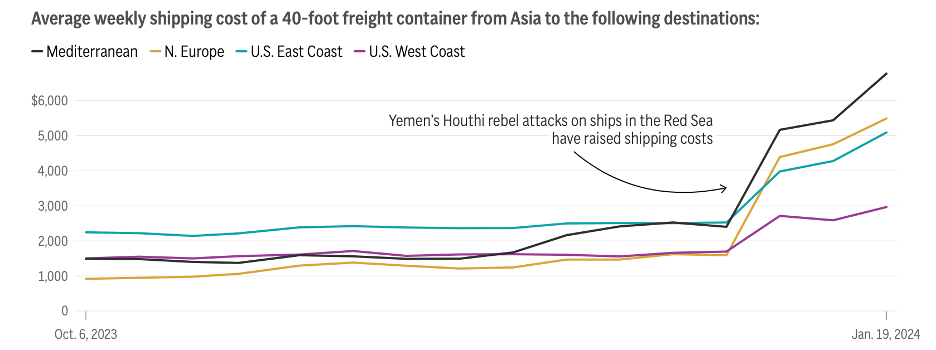
“It’s a damn shame what the world’s gotten to
For people like me and people like you
Wish I could just wake up and it not be true
But it is, oh, it is”
— Oliver Anthony, Rich Men North of Richmond
I couldn’t help but be reminded of the above lyrics, while reading the headlines on Saturday…
“U.S. launches strikes in Iraq, Syria…”
More war. It’s hard not to be depressed.
And it’s not just the tragedy of war that makes it horrible.
It’s the desire to start them in the first place.
In the case of the proxy war with Russia in the Ukraine, it’s clear that “they” not only wanted it to start, they have wanted it to continue.
Or how about Iran?
In September 2023, in a prisoner exchange, the White House agreed to release $6 billion to Iran, a country that former U.S. Ambassador to the United Nations Mark Wallace said “is hellbent on developing a nuclear weapon and it sees that it’s not being checked in any way.”
Less than a month later, Hamas, backed by Iran, launched its horrific attack on Israel, which has led to a terrible conflict between Israel and Hamas in Palestine.
Common sense would usually dictate that Iran should be cut off. No more funding.
But sadly the pattern continued.
Last November, the White House unfroze another $10 billion for Iran that was held by sanctions. The funds were owed to Iran from Iraq.
How could that possibly go well? It didn’t.
Iranian funds flowed to Hezbollah and the Houthis, which are responsible for the attacks on shipping in the Red Sea.
The impact on global trade has been terrible.

Seen above, the cost of shipping containers on certain routes has jumped by as much as 3.6-times since December.
Naturally, prices for finished goods are rising as well. And many factories have temporarily shut down due to the delays in shipping.
As if that wasn’t enough, this weekend brought us the news that the U.S. is attacking Iran-linked targets in Iraq and Syria.
A wider war in the Middle East is actually underway… and it appears that it is funded by the U.S.
Enough is enough.
I suspect that’s how most of us feel right now.
Rational, peaceful people don’t like war. We feel that it should be avoided at all costs, not funded. And we tend to believe that our governments wouldn’t instigate wars.
But that’s a mistake.
It is one of my largest learnings over the last three years, and one of the most painful things that I’ve had to accept.
The things that have been categorized as conspiracy theories over the years, so far-out as to seem impossible, have proven to be true over and over again.
We have entered a time of chaos caused by a very small number of people. Some are now referring to it as World War III.
It is warfare, and yet it is unlike what we have known as war.
It has warped into something quite different.
It’s less about tanks, troops, and fighter jets. It’s more about cyberattacks, psychological warfare (i.e. through social media), weaponized drones, hypersonic weapons, space-based lasers, or releasing man-made pathogens on a global population.
It’s frightening, I know. Warfare has quickly become high-tech enabled.
So much so that it’s not military subcontractors north of Richmond, VA developing the technology.
It’s now coming from Silicon Valley.
This has been a difficult development for many to accept.
In a world where virtue signaling about “clean energy,” “sustainability,” and “making the world a better place” are the norm, developing the technology for military applications, not surprisingly, has not been a popular subject…
For most private tech companies working in this space, this has led to them operating in stealth — doing their best to avoid any publicity at all.
A perfect example is White Stork, a company that I’m pretty sure none of us have heard of.
Its existence was discovered less than a month ago, and its name revealed just a few days ago.
It’s a company we should watch.
White Stork had been disguised within a tangle of LLCs (limited liability corporations), keeping it under the radar from most.
Backing White Stork however is none other than Eric Schmidt, former CEO of Google.
Schmidt is a tech billionaire who has become quite involved, behind the scenes, in U.S. policy as it pertains to technology. He has been particularly active in discussions regarding national security.
The mission of White Stork is to mass produce attack drones in the U.S.
And the Ukraine, a place Schmidt has visited, is intended to be its testing grounds.
Not surprisingly, the drones will use forms of artificial intelligence (AI) to identify and home in on desired targets… while avoiding any kind of jamming technology. In historical warfare, jamming technology can be used to sever communications links between an opponent and their weapon.
Furthermore, the drones will be capable of carrying out their programmed mission even in the absence of a communications link. Thus they can operate in a fully autonomous mode — without the need for any human oversight.
And that means AI-powered warfare.
Whether we like it or not, this is the future of warfare.
Let’s consider a Tesla as an analog of this AI-powered technology.
Long-time readers will recall that a Tesla, running its full self-driving (FSD) software, has the ability to ingest real-time data from its cameras and infer the correct actions to operate a car and reach its destination.
In a similar way, battery-powered drones with military-grade explosives as their payloads will be able to do the same.
Targets might be infrastructure or buildings, or even individual targets, as these drones can be equipped with the ability for facial recognition technology.
GPS coordinates can be provided to the drones, as well as images of the target for the drone to confirm its strike in the seconds before annihilation.
And intelligent attack drones won’t even need GPS to make it to their destinations. If a GPS signal is jammed, the attack drone will be able to continue its mission flying on “sight,” much in the way that we drive our own cars.
This kind of technology can also be used for defensive capabilities. Autonomous drones can act as sentinels that “work” in shifts between charging — programmed to “stand watch” over a a border, facility, or people and spot, identify, and act upon threats.
One of the earliest Silicon Valley startups to enter this space is Anduril.
Founded in 2017, it originally focused on defense applications, specifically counter-UAS (unmanned aircraft systems). This is extremely useful defensive technology designed to identify, track, and eliminate threats. It’s the kind of technology that we want protecting us.
Anduril was founded by Palmer Lucky, the former founder of Oculus, the groundbreaking virtual reality company that was acquired by Facebook back in 2014 for $2 billion.
Anduril, and Lucky, were deeply unpopular for years in the tech community because of the defense and military focus.
And yet venture capitalists, who understood the shifting sands of warfare and tech’s impact, quietly invested more than $2 billion since its founding.
And this leads us to an uncomfortable truth.
Today, Anduril, while still private, is worth an incredible $10 billion.
Anduril now has an entire line up of both counter-UAS and counter intrusion technology, as well as offensive capabilities like the Roadrunner high-explosive interceptor.

Lucky’s team has since innovated further with its drone technology to build the accurately named Fury, an ominous looking autonomous drone designed for the reality of today’s modern warfare.

A land-based equivalent of the drone Anduril has built — and what White Stork plans on building — is RRAI Defense.
Its land-based autonomous vehicles are capable of operating above or below ground in highly unstructured environments.

And Saronic Technologies is a maritime version of this kind of autonomous technology, capable of operating in swarms as an augmentation to naval activities.

Speaking of swarms, another AI-powered company, Shield AI, has built an AI pilot called Hivemind… capable of autonomously controlling both drones and even aircraft for defense purposes.
Shield AI’s technology was recently used in the aftermath of the Hamas attacks on Israel.
We’re clearly in an environment where there is demand for such technologies. Massive government spending is driving billions of dollars in investment.
And as uncomfortable as it is to think about technology used in this way, we must accept this rapidly evolving landscape… and understand potential investment implications.
The best-case scenario is that these technologies would only be used as a deterrence for war.
But based on what we’ve seen over the last few years, I doubt we’ll be so lucky.
There appears to be no shortage for the desire to start conflict. And there appears to be no limit to what the government is willing to spend.
Despite the offensive capabilities of these products, there is, however, one thing I’m sure of…
Any country that is being attacked — that doesn’t have access to this kind of technology — will have little to no chance of a victory.
And none of this technology would be possible without the employment of artificial intelligence.
What do you think of this issue of Outer Limits? As always, we welcome your feedback and questions, and look forward to them. We read each and every email and address common questions in the Friday AMA issues. Please write to us by clicking here.